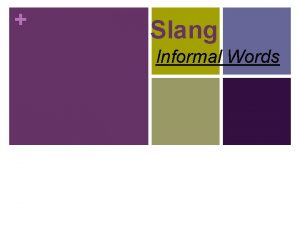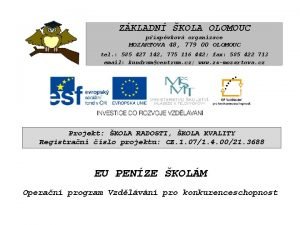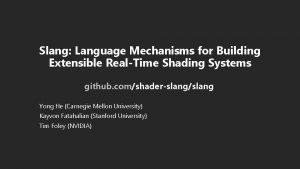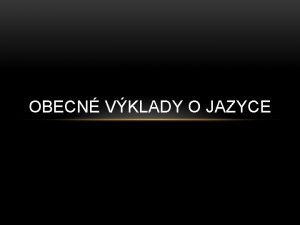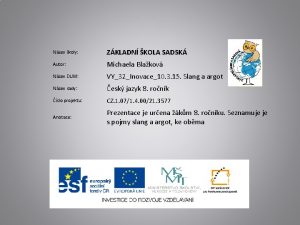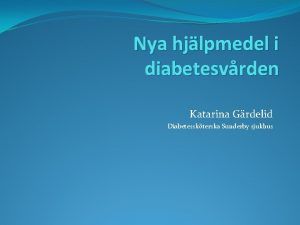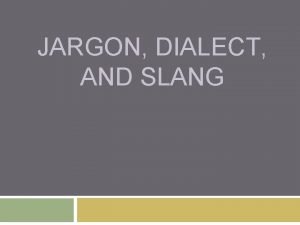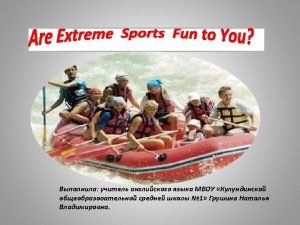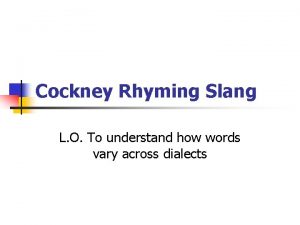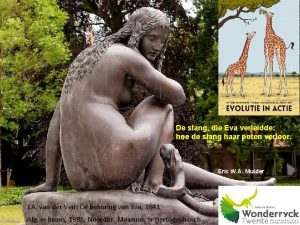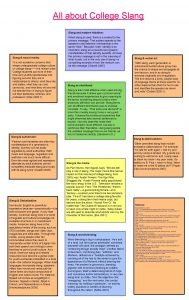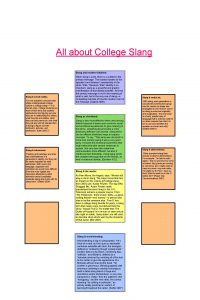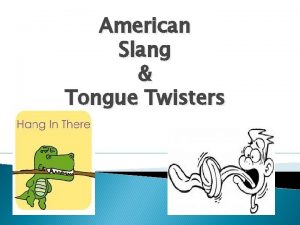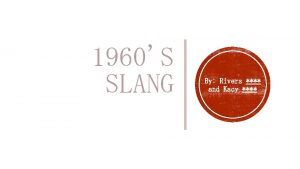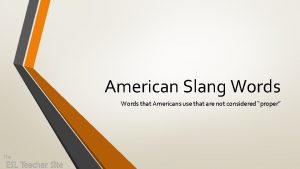The Use of Slang Words in Informal Communication













- Slides: 13

The Use of Slang Words in Informal Communication Among Universities Student in Tangerang BY GIA SUCI DAMAYANTI 1688203154

Background and Focus of the Research Now days, English seems to be very popular among the people, not only in Indonesia, but also in all corners of the world. Because now is the era of globalization, and English is the language used in international languages. Based on the background of the research, the researcher focused on her study to observe the students English used the slang words in their informal communication among students Universities.

Formulation of the Problems Objective of the research Formulation Based on the focus of the research, the researcher formulated the problems into the following questions: What kind of slang words used by the students among Universities of Tangerang? What are the meaning of slang words used by students among Universities of Tangerang in informal Communication? Objective …

Theoritical Framework Language phenomena Nowdays, many people are using slang in their informal communication. Many people now are consider slang to be an insightful and an intelligent variation to the blendness of the standard language. According to Owen in Setiawan (2006: p. 1), explains the definition of language that is language can be defined as a socially shared combinations of those symbols and rules governed combinations of those symbols

Slang and History of slang q. In Indonesia, slang has been popular since 1970 and people started to use it. This phenomenon is wide spreads among children from the transition’s age to teenagers q. Slang first appeared in print around 1800, applied to the speech of disreputable and criminal classes in London. The term, however, was probably used much earlier q. According to Random House Historical Dictionary of American slang and from book “ Slang : Today and Yesterday” by Patridge (2004), there are five periods of slang history and each of them has different characteristics.

Types of slang According to Anderson and Trudgill (1983) in their book about “Bad Language” there are many the typical of slangs : 1. Slang is typical of the informal situation 2. Slang is typical of spoken language 3. Slang is found in words not in grammar 4. Slang is not swearing 5. Slang is not register 6. Slang is not cant, argot or jargon 7. Slang is creative 8. Slang changes naturally all the time.

Characteristic of slang Some of the slang expressions are acceptable and the others are rude and impolite. The words may be considered as slang if they fulfill one or more these characteristics. Characteristics of slanguage. (2011) 1. CREATIVE 2. FLIPPANT 3. FRESH 4. ONOMATOPOIEC

COMMUNICATIONS Understanding Communication in General is the process of sending and receiving messages or information between two or more individuals effectively so that they can be understood easily. In this case there are 2 communication : 1. informal communications 2. formal communication

Relevant studies Many linguist have studied and conducted researches of language study and phenomena but this field of study remains interesting to explore until now. It can be seen in some previous research relevant to the topic of this research, especially in slang words. First from Winda Pradianti (2013) Second Marhana Rullu (2017) And the last from Firooz namvar

Approach and Method of the Research Place and time of the Research Approach/ method : The researcher has purpose to analyze students in their informal communication in classroom when doing their English class among students in Tangerang specially at Muhammadiyah University, University of Islam Syekh Yusuf and Budhi Darma University. The steps are…. . Place n time : The researcher will conducted at 3 universities, The researcher choose that universities because the language learning strategy is an important thing and also saving time through the locations.

Source and Type of Research Data Technique of Data Collection Source : In this research the source of information in this research will be taken from randomly students in English department among universities of tangerang. The researcher used questionnaire instrument to find out what are slang words often used among the students. Technique : There are three types technique of collecting data, there are three data collecting technique. Those are observation, questionnaire, and documentation.

Instrument of the Research Technique of Analyzing Data Instrument : According to Sugiyono (2008: p. 222) stated that in qualitative research, the instrument is the researcher themselves. The researcher should be validated by themselves about their ability in conducting research. Technique : After collecting the data, the researcher analyzes the data. Wiersma (1991: p. 85) stated data analysis in qualitative research is a process of categorization, description, and synthesis. To analyze the data, the researcher uses descriptive qualitative to analyze data. According to Sugiyono (2008: p. 245), there are three activities to analyze data in descriptive qualitative research. Those activities are data reduction, data display and conclusion.

Thank you…


